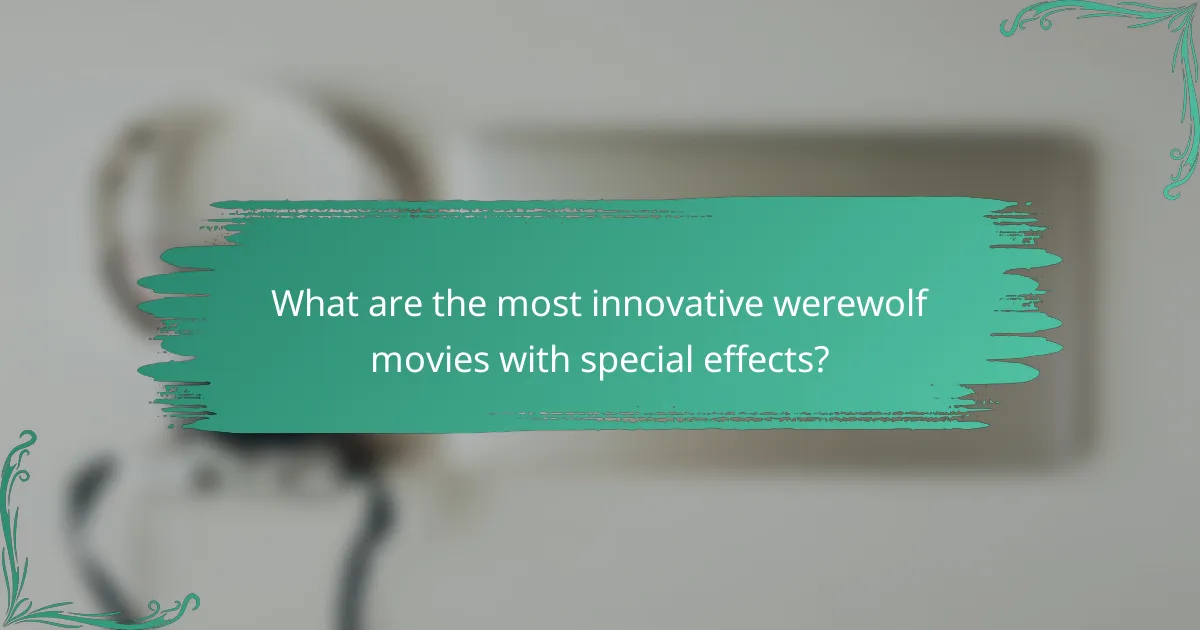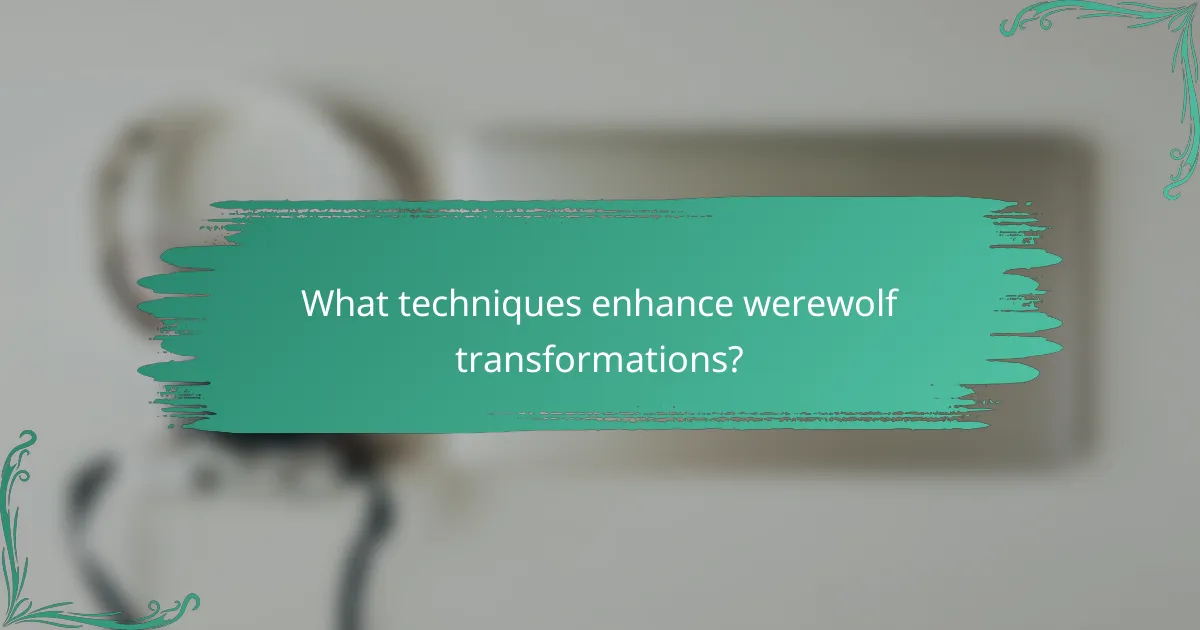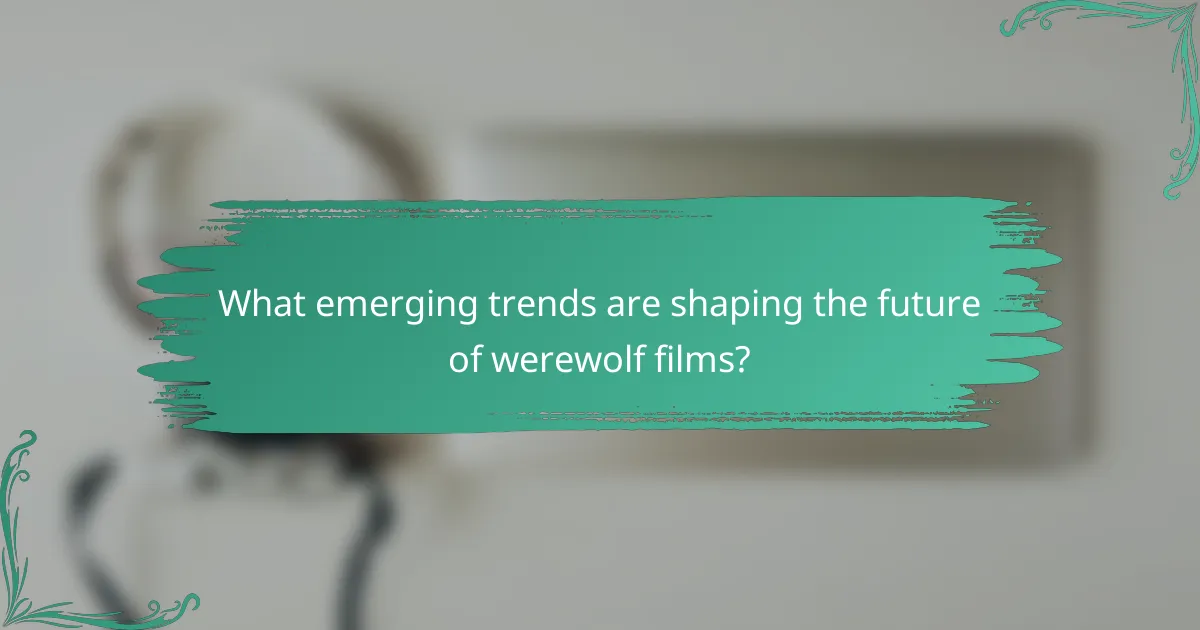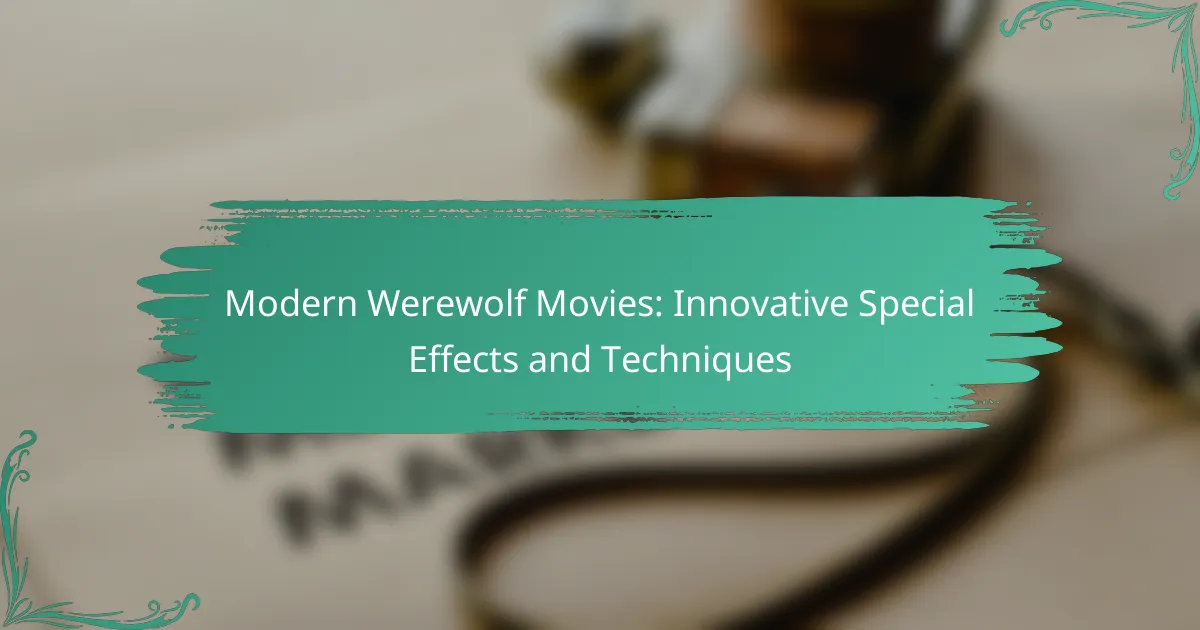Modern werewolf movies have revolutionized the genre through innovative special effects that bring the terrifying transformation of humans into beasts to life. By combining practical effects, CGI, and advanced techniques like motion capture, filmmakers create immersive experiences that captivate audiences and elevate the horror of lycanthropy. These advancements not only enhance visual storytelling but also deepen the emotional impact of the narrative.

What are the most innovative werewolf movies with special effects?
Innovative werewolf movies utilize groundbreaking special effects to create realistic transformations and engaging narratives. These films often blend practical effects with CGI to enhance the viewer’s experience and showcase the horror of lycanthropy.
American Werewolf in London
Released in 1981, “American Werewolf in London” is renowned for its groundbreaking transformation scene, which set a new standard for special effects in horror films. The use of practical effects, including animatronics and prosthetics, created a visceral and terrifying transformation that remains iconic.
The film’s special effects team, led by Rick Baker, won the first-ever Academy Award for Best Makeup, highlighting the impact of their innovative techniques. This film demonstrates the power of practical effects in creating a believable horror experience.
Dog Soldiers
The werewolf designs in “Dog Soldiers” emphasize the ferocity and primal nature of the creatures, enhancing the film’s tension. The blend of action and horror, along with its innovative effects, has earned it a cult following among genre fans.
The Howling
Released in 1981, “The Howling” is notable for its unique approach to werewolf lore and its special effects. The film features a mix of practical effects and innovative techniques, including the use of morphing effects that were groundbreaking for its time.
The transformation scenes are characterized by their fluidity and creativity, showcasing the werewolves in a way that emphasizes their animalistic traits. “The Howling” remains a significant entry in the werewolf genre, influencing many films that followed.
Ginger Snaps
“Ginger Snaps,” released in 2000, offers a fresh take on the werewolf mythos by intertwining themes of adolescence and transformation. The film’s special effects focus on the psychological aspects of lycanthropy, using practical effects to depict the physical changes in the characters.
The werewolf transformations in “Ginger Snaps” are subtle yet impactful, reflecting the internal struggles of the characters. This innovative approach to werewolf lore has made the film a standout in the genre, appealing to both horror and coming-of-age audiences.
WolfCop
“WolfCop,” released in 2014, is a unique blend of comedy and horror that revitalizes the werewolf genre with its over-the-top special effects. The film employs practical effects, makeup, and creative CGI to deliver a humorous yet thrilling take on lycanthropy.
The transformation scenes are exaggerated and entertaining, showcasing the film’s commitment to fun and creativity. “WolfCop” stands out for its ability to balance horror and humor while employing innovative techniques that keep viewers engaged.

How do modern werewolf movies use special effects?
Modern werewolf movies utilize a combination of practical effects, CGI, and makeup transformations to create realistic and engaging transformations. These techniques enhance the visual storytelling and immerse the audience in the supernatural experience.
Practical effects and animatronics
Practical effects and animatronics involve physical models and mechanical devices to depict werewolf transformations. These methods provide tangible, realistic visuals that can enhance the authenticity of scenes. For example, animatronic limbs can simulate movement, adding a layer of realism that CGI sometimes lacks.
Filmmakers often use practical effects for close-up shots, where the detail and texture of the werewolf can be more effectively captured. This approach can be more cost-effective than extensive CGI, especially for independent films with limited budgets.
CGI advancements
CGI advancements have revolutionized how werewolves are depicted on screen, allowing for more fluid and dynamic transformations. Modern software enables filmmakers to create intricate details, such as fur movement and facial expressions, that would be difficult to achieve with practical effects alone.
However, relying too heavily on CGI can lead to a disconnect with the audience. A balanced approach, combining CGI with practical effects, often yields the most compelling results. Filmmakers should consider the emotional impact of scenes when deciding how much CGI to use.
Makeup transformations
Makeup transformations are essential in creating the initial stages of a werewolf’s change. Skilled makeup artists can use prosthetics and special effects makeup to depict the gradual transformation, enhancing the character’s physical features without relying solely on digital effects.
Using high-quality materials and techniques, such as latex and silicone, allows for realistic skin textures and facial features. Filmmakers should ensure that makeup is applied in a way that complements both practical and digital effects, creating a seamless transition during transformation scenes.

What techniques enhance werewolf transformations?
Techniques that enhance werewolf transformations primarily include time-lapse effects, motion capture technology, and hybrid effects blending. These methods create visually compelling transformations that engage audiences and elevate storytelling in modern werewolf films.
Time-lapse effects
Time-lapse effects simulate the gradual transformation of a character into a werewolf, allowing viewers to witness the change in a condensed timeframe. This technique often involves filming the transformation in real time and then speeding up the footage during editing.
To effectively use time-lapse effects, filmmakers should consider the pacing of the transformation. A typical sequence might last anywhere from a few seconds to a couple of minutes, depending on the desired intensity. Careful attention to detail in makeup and prosthetics is crucial to maintain realism.
Motion capture technology
Motion capture technology records the movements of an actor and translates them into a digital format, allowing for realistic animations of werewolf transformations. This technique captures the nuances of human movement, which can then be applied to a CGI werewolf model.
When using motion capture, it is essential to select skilled performers who can convey the physicality of a werewolf. The integration of motion capture with traditional effects can enhance the believability of the transformation, making it more immersive for the audience.
Hybrid effects blending
Hybrid effects blending combines practical effects, such as makeup and animatronics, with digital effects to create a seamless transformation. This approach allows filmmakers to leverage the strengths of both techniques, resulting in a more convincing werewolf appearance.
For successful hybrid effects, it is important to ensure that the practical effects are designed to work in harmony with the digital enhancements. This might involve careful planning during pre-production and collaboration between makeup artists and visual effects teams to achieve a cohesive look.

How do werewolf movies compare to other horror genres?
Werewolf movies stand out in the horror genre due to their unique blend of transformation, folklore, and psychological elements. Unlike traditional horror films that rely heavily on jump scares or supernatural entities, werewolf narratives often explore the duality of human nature and the struggle between civilization and primal instincts.
Unique narrative structures
Werewolf films frequently employ innovative narrative structures that emphasize transformation and identity crisis. Many stories unfold through the perspective of the protagonist, allowing viewers to experience their internal conflict as they grapple with their emerging beastly nature. This approach can create a more immersive experience compared to linear storytelling found in other horror genres.
Additionally, werewolf narratives often incorporate flashbacks or parallel timelines, revealing the character’s past and the origins of their curse. This complexity adds depth to the plot, engaging the audience in a way that straightforward horror films may not.
Character development focus
Character development is a cornerstone of werewolf movies, often delving into the psychological impact of transformation. The protagonist’s journey typically explores themes of isolation, fear, and the struggle for control, making their evolution central to the story. This focus on character allows for a richer emotional experience, contrasting with other horror genres that may prioritize plot over personal growth.
Moreover, secondary characters often play significant roles, either as allies or antagonists, reflecting the protagonist’s internal battle. Their interactions can highlight societal fears and moral dilemmas, adding layers to the narrative that resonate beyond mere fright.
Symbolism in folklore
Werewolf movies draw heavily from folklore, using symbolism to convey deeper meanings about humanity and nature. The transformation into a wolf often represents the loss of control and the unleashing of primal instincts, serving as a metaphor for the darker aspects of human nature. This symbolism can resonate with audiences, prompting reflection on their own inner struggles.
Additionally, the werewolf mythos often explores themes of duality and the conflict between civilization and savagery. By incorporating these elements, filmmakers can create stories that not only entertain but also provoke thought about societal norms and personal identity, distinguishing werewolf films from other horror narratives.

What are the key criteria for evaluating werewolf movie effects?
Key criteria for evaluating werewolf movie effects include the realism of transformations, audience immersion, and the historical accuracy of lore. These elements contribute significantly to the overall impact and believability of the film, influencing viewer engagement and satisfaction.
Realism of transformations
The realism of transformations in werewolf movies hinges on the quality of special effects, makeup, and CGI. Effective transformations should evoke a sense of authenticity, making viewers believe in the physical change from human to wolf. Techniques such as practical effects combined with digital enhancements often yield the most convincing results.
For example, films that utilize animatronics or detailed prosthetics can create a tangible sense of horror, while CGI can enhance these effects by adding fluidity and dynamism. Balancing these methods is crucial; over-reliance on CGI can detract from the realism, leading to a less impactful experience.
Audience immersion
Audience immersion is achieved when viewers feel emotionally and psychologically engaged with the film. This can be enhanced through sound design, cinematography, and the pacing of transformation scenes. A well-crafted atmosphere can draw viewers into the story, making them feel the tension and fear associated with the werewolf’s presence.
To maximize immersion, filmmakers should focus on creating relatable characters and situations that resonate with the audience. Effective use of suspense and surprise can keep viewers on the edge of their seats, enhancing their overall experience.
Historical accuracy of lore
The historical accuracy of werewolf lore adds depth and credibility to the narrative. Many viewers appreciate films that respect traditional myths and legends surrounding werewolves, as this can enrich the storytelling. Incorporating elements from various cultures’ folklore can provide a unique twist while maintaining authenticity.
Filmmakers should research the origins of werewolf myths, such as those from European folklore or Native American traditions, to create a more engaging and believable narrative. Striking a balance between creative interpretation and factual representation is key to satisfying both casual viewers and lore enthusiasts.

What emerging trends are shaping the future of werewolf films?
Emerging trends in werewolf films are increasingly focused on innovative special effects and immersive storytelling techniques. Advances in technology, particularly in virtual reality and CGI, are transforming how audiences experience these films, making the werewolf lore more engaging and visually stunning.
Virtual reality experiences
Virtual reality (VR) experiences are revolutionizing the way audiences interact with werewolf narratives. By immersing viewers in a 360-degree environment, VR allows them to step into the shoes of characters, enhancing emotional engagement and suspense. This technology creates a unique opportunity for filmmakers to explore the werewolf mythos in a more personal and visceral manner.
To create effective VR werewolf experiences, filmmakers need to focus on high-quality graphics and sound design. Realistic animations and immersive audio can significantly enhance the experience, drawing users deeper into the story. For example, a VR werewolf hunt can simulate the tension of being pursued, making the viewer feel the adrenaline of the chase.
However, filmmakers should be mindful of the potential for motion sickness in VR. Ensuring smooth transitions and minimizing rapid movements can help maintain viewer comfort. Additionally, providing clear instructions on how to navigate the VR environment can enhance user experience and accessibility.
